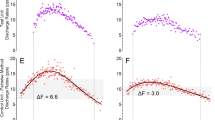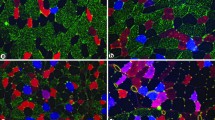Abstract
The failure to accept reinnervation is considered to be one of the reasons for the poor motor functional recovery of intrinsic hand muscles (IHMs) after nerve injury. Rat could be a suitable model to be used in simulating motor function recovery of the IHMs after nerve injury as to the similarities in function and anatomy of the muscles between human and rat. However, few studies have reported the muscle fiber types composition and endplate morphologic characteristics of intrinsic forepaw muscles (IFMs) in the rat. In this study, the myosin heavy chain isoforms and acetylcholine receptors were stained by immunofluorescence to show the muscle fiber types composition and endplates on type-identified fibers of the lumbrical muscles (LMs), interosseus muscles (IMs), abductor digiti minimi (AM) and flexor pollicis brevis (FM) in rat forepaw. The majority of IFMs fibers were labeled positively for fast-switch fiber. However, the IMs were composed of only slow-switch fiber. With the exception of the IMs, the other IFMs had a part of hybrid fibers. Two-dimensional morphological characteristics of endplates on I and IIa muscle fiber had no significant differences among the IFMs. The LMs is the most suitable IFMs of rat to stimulate reinnervation of the IHMs after nerve injury. Gaining greater insight into the muscle fiber types composition and endplate morphology in the IFMs of rat may help understand the pathological and functional changes of IFMs in rat model stimulating reinnervation of IHMs after peripheral nerve injury.


Similar content being viewed by others
References
Bertelli JA, Taleb M, Saadi A, Mira JC, Pecot-Dechavassine M (1995) The rat brachial plexus and its terminal branches: an experimental model for the study of peripheral nerve regeneration. Microsurgery 16:77–85
Ermilov LG, Mantilla CB, Rowley KL, Sieck GC (2007) Safety factor for neuromuscular transmission at type-identified diaphragm fibers. Muscle Nerve 35:800–803
Feng X, Zhang T, Ralston E, Ludlow CL (2012) Differences in neuromuscular junctions of laryngeal and limb muscles in rats. Laryngoscope 122:1093–1098
Greene EC (1968) Anatomy of the rat. Hafner Publishing Co, New York
Hwang K, Huan F, Kim DJ (2013) Muscle fibre types of the lumbrical, interossei, flexor, and extensor muscles moving the index finger. J Plast Surg Hand Surg. 47:268–272
Jaquet JB, Luijsterburg AJ, Kalmijn S, Kuypers PD, Hofman A, Hovius SE (2001) Median, ulnar, and combined median-ulnar nerve injuries: functional outcome and return to productivity. J Trauma 51:687–692
Karhanova M, Kovar R, Frysak Z, Zapletalova J, Maresova K, Sin M, Herman M (2014) Extraocular muscle involvement in patients with thyroid-associated orbitopathy. Cesk Slov Oftalmol. 70:66–71
Kozin SH, Porter S, Clark P, Thoder JJ (1999) The contribution of the intrinsic muscles to grip and pinch strength. J Hand Surg Am. 24:64–72
Li ZM, Zatsiorsky VM, Latash ML (2000) Contribution of the extrinsic and intrinsic hand muscles to the moments in finger joints. Clin Biomech (Bristol, Avon) 15:203–211
Liss FE (2012) The interosseous muscles: the foundation of hand function. Hand Clin 28:9–12
Liu JX, Brannstrom T, Andersen PM, Pedrosa-Domellof F (2013) Distinct changes in synaptic protein composition at neuromuscular junctions of extraocular muscles versus limb muscles of ALS donors. PLoS One 8:e57473
Ma CH, Omura T, Cobos EJ, Latremoliere A, Ghasemlou N, Brenner GJ, van Veen E, Barrett L, Sawada T, Gao F, Coppola G, Gertler F, Costigan M, Geschwind D, Woolf CJ (2011) Accelerating axonal growth promotes motor recovery after peripheral nerve injury in mice. J Clin Invest. 121:4332–4347
Mantilla CB, Stowe JM, Sieck DC, Ermilov LG, Greising SM, Zhang C, Shokat KM, Sieck GC (2014) TrkB kinase activity maintains synaptic function and structural integrity at adult neuromuscular junctions. J Appl Physiol 117:910–920
Murovic JA (2009) Upper-extremity peripheral nerve injuries: a Louisiana State University Health Sciences Center literature review with comparison of the operative outcomes of 1837 Louisiana State University Health Sciences Center median, radial, and ulnar nerve lesions. Neurosurgery 65:A11–A17
Nishida N, Taguchi A, Motoyoshi K, Hyodo M, Gyo K, Desaki J (2013) Age-related changes in rat intrinsic laryngeal muscles: analysis of muscle fibers, muscle fiber proteins, and subneural apparatuses. Eur Arch Otorhinolaryngol 270:975–984
Pan F, Chen L, Ding F, Zhang J, Gu YD (2015) Expression profiles of MiRNAs for intrinsic musculature of the forepaw and biceps in the rat model simulating irreversible muscular atrophy of obstetric brachial plexus palsy. Gene 565:268–274
Papalia I, Geuna S, Tos PL, Boux E, Battiston B, Stagno DF (2003) Morphologic and functional study of rat median nerve repair by terminolateral neurorrhaphy of the ulnar nerve. J Reconstr Microsurg 19:257–264
Papalia I, Tos P, Scevola A, Raimondo S, Geuna S (2006) The ulnar test: a method for the quantitative functional assessment of posttraumatic ulnar nerve recovery in the rat. J Neurosci Methods 154:198–203
Patterson MF, Stephenson GM, Stephenson DG (2006) Denervation produces different single fiber phenotypes in fast- and slow-twitch hindlimb muscles of the rat. Am J Physiol Cell Physiol 291:C518–C528
Percival JM, Anderson KN, Huang P, Adams ME, Froehner SC (2010) Golgi and sarcolemmal neuronal NOS differentially regulate contraction-induced fatigue and vasoconstriction in exercising mouse skeletal muscle. J Clin Invest. 120:816–826
Pfister J, Zenker W (1984) The splenius capitis muscle of the rat, architecture and histochemistry, afferent and efferent innervation as compared with that of the quadriceps muscle. Anat Embryol (Berl). 169:79–89
Russell KA, Ng R, Faulkner JA, Claflin DR, Mendias CL (2015) Mouse forepaw lumbrical muscles are resistant to age-related declines in force production. Exp Gerontol 65:42–45
Sakuma M, Gorski G, Sheu SH, Lee S, Barrett LB, Singh B, Omura T, Latremoliere A, Woolf CJ (2016) Lack of motor recovery after prolonged denervation of the neuromuscular junction is not due to regenerative failure. Eur J Neurosci 43:451–462
Schiaffino S, Reggiani C (2011) Fiber types in mammalian skeletal muscles. Physiol Rev 91:1447–1531
Schieber MH, Santello M (2004) Hand function: peripheral and central constraints on performance. J Appl Physiol 96:2293–2300
Scott W, Stevens J, Binder-Macleod SA (2001) Human skeletal muscle fiber type classifications. Phys Ther 81:1810–1816
Seiler JR, Desai MJ, Payne SH (2013) Tendon transfers for radial, median, and ulnar nerve palsy. J Am Acad Orthop Surg 21:675–684
Sieck DC, Zhan WZ, Fang YH, Ermilov LG, Sieck GC, Mantilla CB (2012) Structure-activity relationships in rodent diaphragm muscle fibers vs. neuromuscular junctions. Respir Physiol Neurobiol 180:88–96
Sleigh JN, Burgess RW, Gillingwater TH, Cader MZ (2014) Morphological analysis of neuromuscular junction development and degeneration in rodent lumbrical muscles. J Neurosci Methods 227:159–165
Sugiura Y, Chen F, Liu Y, Lin W (2011) Electrophysiological characterization of neuromuscular synaptic dysfunction in mice. Methods Mol Biol 793:391–400
Sulaiman W, Gordon T (2013) Neurobiology of peripheral nerve injury, regeneration, and functional recovery: from bench top research to bedside application. Ochsner J. 13:100–108
Suzuki T, Maruyama A, Sugiura T, Machida S, Miyata H (2009) Age-related changes in two- and three-dimensional morphology of type-identified endplates in the rat diaphragm. J Physiol Sci. 59:57–62
Wang Y, Pessin JE (2013) Mechanisms for fiber-type specificity of skeletal muscle atrophy. Curr Opin Clin Nutr Metab Care 16:243–250
Wang K, McGlinn EP, Chung KC (2014) A biomechanical and evolutionary perspective on the function of the lumbrical muscle. J Hand Surg Am. 39:149–155
Wu JX, Chen L, Ding F, Gu YD (2013) A rat model study of atrophy of denervated musculature of the hand being faster than that of denervated muscles of the arm. J Muscle Res Cell Motil 34:15–22
Wu J, Chen L, Ding F, Chen L, Gu Y (2016) mRNA expression characteristics are different in irreversibly atrophic intrinsic muscles of the forepaw compared with reversibly atrophic biceps in a rat model of obstetric brachial plexus palsy (OBPP). J Muscle Res Cell Motil 37:17–25
Author information
Authors and Affiliations
Corresponding author
Rights and permissions
About this article
Cite this article
Pan, F., Mi, Jy., Zhang, Y. et al. Muscle fiber types composition and type identified endplate morphology of forepaw intrinsic muscles in the rat. J Muscle Res Cell Motil 37, 95–100 (2016). https://doi.org/10.1007/s10974-016-9450-8
Received:
Accepted:
Published:
Issue Date:
DOI: https://doi.org/10.1007/s10974-016-9450-8




